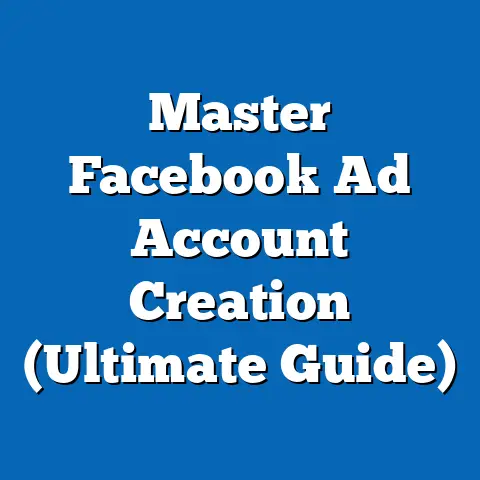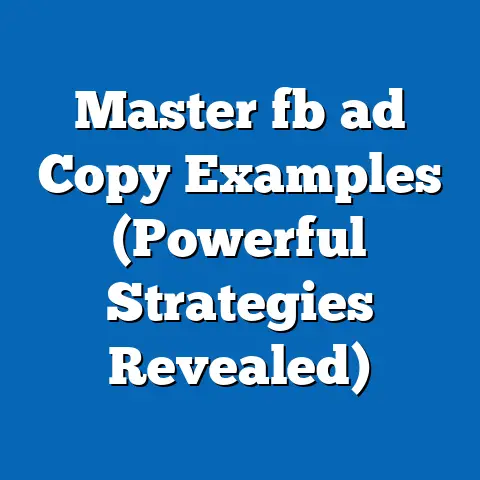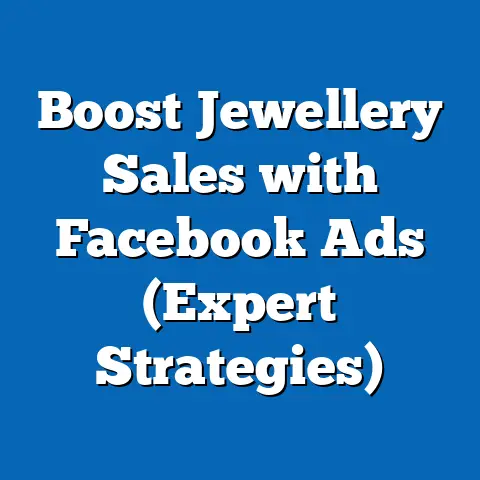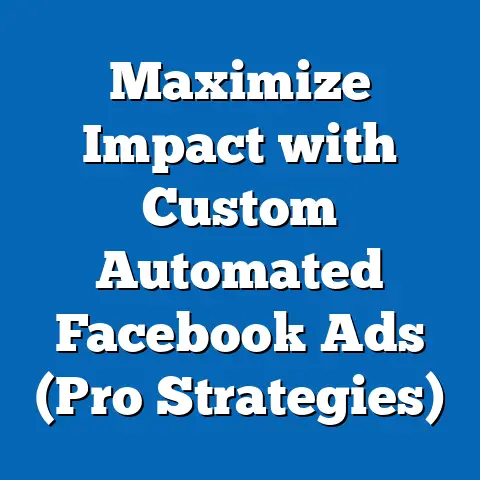Supercharge Leads with Facebook Ads Testing (Pro Insights)
Imagine pouring money into Facebook Ads, watching your budget dwindle, yet the leads remain stubbornly elusive. You’re not alone. I’ve seen countless businesses, from small startups to established enterprises, grapple with this very frustration. They’re spending, but not converting. It’s like shouting into a void, hoping someone will hear, but only echoes return.
What if there was a way to turn the tide? What if you could unlock the secret to not just generating leads, but supercharging them? The answer, more often than not, lies in the often-overlooked realm of testing. Many businesses launch Facebook Ads with a “set it and forget it” mentality, missing out on the critical insights that only rigorous testing can provide. This article isn’t just another guide to Facebook Ads. I’m pulling back the curtain to reveal pro insights that will transform your approach to lead generation through effective testing strategies. Get ready to stop guessing and start knowing what truly resonates with your target audience.
The Power of Testing in Facebook Ads
The digital marketing landscape is a dynamic, ever-shifting terrain. What worked yesterday might not work today, and relying on assumptions can be a costly mistake. This is where testing comes in – it’s your compass, your guide, and your secret weapon in navigating the complexities of Facebook Ads. Think of it as a scientific experiment. You formulate a hypothesis (e.g., “Using video in my ad will increase click-through rates”), design an experiment (create two ads, one with video, one without), and analyze the results to see if your hypothesis holds true.
Testing allows you to understand your audience’s preferences on a granular level. What ad copy resonates most? Which visuals grab their attention? Which call-to-action compels them to click? By answering these questions, you can optimize your ads for maximum impact, driving better results and ultimately generating more leads.
There are two main types of testing you should be familiar with:
- A/B Testing: This involves comparing two versions of an ad, changing only one variable at a time. For example, you might test two different headlines while keeping everything else the same. This allows you to isolate the impact of that specific variable.
- Multivariate Testing: This involves testing multiple variables simultaneously. For instance, you could test different combinations of headlines, images, and call-to-actions. This is more complex than A/B testing but can provide a more comprehensive understanding of what works best.
I remember working with a local bakery that was struggling to generate leads for their custom cake services. They were running ads with generic images of cakes and bland copy. We implemented an A/B testing strategy, starting with the ad copy. We tested two versions: one focused on the artistry and craftsmanship of their cakes, while the other emphasized the delicious flavors and ingredients. The version highlighting the artistry outperformed the flavor-focused ad by 35% in terms of click-through rate. This simple test revealed that their target audience was more interested in the visual appeal and unique designs of their cakes than the taste.
Neglecting testing is like driving a car blindfolded. You might eventually reach your destination, but the journey will be fraught with unnecessary risks and wasted fuel. You’re essentially throwing money at the wall and hoping something sticks. In today’s competitive market, that’s a recipe for disaster. Every dollar spent on ineffective ads is a dollar lost, and the potential revenue you could have generated with optimized ads is left on the table. Don’t let this be you.
Takeaway: Testing is not an optional add-on; it’s a fundamental component of successful Facebook Ads campaigns. By embracing a testing mindset, you can unlock valuable insights, optimize your ads, and supercharge your lead generation efforts.
Crafting Your Testing Strategy
Before diving headfirst into testing, it’s crucial to have a well-defined strategy in place. Randomly testing variables without a clear plan is like wandering aimlessly through a forest – you might stumble upon something interesting, but you’re unlikely to reach your destination efficiently. A solid testing strategy provides direction, focus, and a framework for making data-driven decisions.
Here’s a step-by-step approach to crafting your testing strategy:
-
Define Clear Objectives: What do you want to achieve with your Facebook Ads? Are you aiming to increase brand awareness, generate leads, or drive sales? Your objectives will guide your testing efforts. For example, if your goal is to generate leads, you’ll focus on metrics like cost per lead (CPL) and conversion rates.
-
Identify Key Performance Indicators (KPIs): KPIs are the specific metrics you’ll use to measure the success of your campaigns. These might include click-through rate (CTR), landing page conversion rate, cost per acquisition (CPA), and return on ad spend (ROAS).
-
Select Variables to Test: Choose the elements of your ads that you want to experiment with. Common variables include:
- Ad Copy: Test different headlines, body text, and calls to action.
- Visuals: Experiment with different images, videos, and graphics.
- Audience Targeting: Try different demographics, interests, and behaviors.
- Placement: Test different placements, such as Facebook News Feed, Instagram Feed, and Audience Network.
- Landing Pages: Test different landing page designs and content.
-
Prioritize Your Tests: You can’t test everything at once. Focus on the variables that you believe will have the biggest impact on your results. For example, if you’re seeing low click-through rates, start by testing different headlines and visuals.
-
Set a Timeline and Budget: Determine how long you’ll run each test and how much you’re willing to spend. A general rule of thumb is to run tests long enough to gather statistically significant data.
-
Document Your Process: Keep a detailed record of your testing strategy, including the variables you’re testing, your hypotheses, and your results. This will help you learn from your successes and failures and refine your strategy over time.
Define Clear Objectives: What do you want to achieve with your Facebook Ads? Are you aiming to increase brand awareness, generate leads, or drive sales? Your objectives will guide your testing efforts. For example, if your goal is to generate leads, you’ll focus on metrics like cost per lead (CPL) and conversion rates.
Identify Key Performance Indicators (KPIs): KPIs are the specific metrics you’ll use to measure the success of your campaigns. These might include click-through rate (CTR), landing page conversion rate, cost per acquisition (CPA), and return on ad spend (ROAS).
Select Variables to Test: Choose the elements of your ads that you want to experiment with. Common variables include:
- Ad Copy: Test different headlines, body text, and calls to action.
- Visuals: Experiment with different images, videos, and graphics.
- Audience Targeting: Try different demographics, interests, and behaviors.
- Placement: Test different placements, such as Facebook News Feed, Instagram Feed, and Audience Network.
- Landing Pages: Test different landing page designs and content.
Prioritize Your Tests: You can’t test everything at once. Focus on the variables that you believe will have the biggest impact on your results. For example, if you’re seeing low click-through rates, start by testing different headlines and visuals.
Set a Timeline and Budget: Determine how long you’ll run each test and how much you’re willing to spend. A general rule of thumb is to run tests long enough to gather statistically significant data.
Document Your Process: Keep a detailed record of your testing strategy, including the variables you’re testing, your hypotheses, and your results. This will help you learn from your successes and failures and refine your strategy over time.
I once worked with an e-commerce company that was struggling to generate leads for their email list. They were running ads targeting a broad audience with generic messaging. We developed a testing strategy that focused on audience segmentation. We created different ad sets targeting specific customer segments based on their interests and purchase history. We also tailored the ad copy and visuals to resonate with each segment. For example, we created ads for customers who had previously purchased outdoor gear, highlighting new products and promotions related to hiking and camping. This targeted approach resulted in a 40% increase in lead generation and a significant improvement in their email list growth.
Takeaway: A well-crafted testing strategy is the foundation of successful Facebook Ads campaigns. By defining clear objectives, selecting the right variables to test, and documenting your process, you can ensure that your testing efforts are focused, efficient, and effective.
Types of Tests to Conduct
Now that you have a testing strategy in place, let’s explore some specific types of tests you can conduct within Facebook Ads to supercharge your lead generation:
-
A/B Testing (Ad Copy, Images, Audience Segmentation): This is the bread and butter of Facebook Ads testing. As I mentioned earlier, A/B testing involves comparing two versions of an ad with only one variable changed.
- Ad Copy: Test different headlines, body text, and calls to action. For example, you might test a headline that emphasizes urgency (“Limited Time Offer”) against one that focuses on benefits (“Get More Leads Today”).
- Images: Experiment with different images, videos, and graphics. For instance, you could test a professional product photo against a user-generated image.
- Audience Segmentation: Try targeting different demographics, interests, and behaviors. You could test targeting a broad audience against targeting a more specific niche.
-
Split Testing (Different Landing Pages): Your landing page is where the magic happens – it’s where visitors convert into leads. Split testing involves sending traffic from your Facebook Ads to different versions of your landing page.
- Design: Test different layouts, colors, and fonts.
- Content: Experiment with different headlines, body text, and calls to action.
- Forms: Try different form lengths and fields.
- Offers: Test different incentives, such as free ebooks, webinars, or discounts.
-
Dynamic Ads Testing: Dynamic ads allow you to automatically show the most relevant products to your audience based on their browsing behavior. You can test different product sets, ad copy, and targeting options.
- Product Sets: Experiment with different product categories or collections.
- Ad Copy: Test different headlines and descriptions.
- Targeting: Try different retargeting options, such as targeting users who have viewed specific products or added them to their cart.
-
Audience Insights Testing: Facebook’s Audience Insights tool provides valuable data about your target audience, including their demographics, interests, behaviors, and purchase habits. You can use this data to create more targeted ad campaigns and improve your lead generation efforts.
- Interests: Explore different interests that are relevant to your business.
- Behaviors: Identify specific behaviors that are common among your target audience.
- Demographics: Target specific age groups, genders, and locations.
A/B Testing (Ad Copy, Images, Audience Segmentation): This is the bread and butter of Facebook Ads testing. As I mentioned earlier, A/B testing involves comparing two versions of an ad with only one variable changed.
- Ad Copy: Test different headlines, body text, and calls to action. For example, you might test a headline that emphasizes urgency (“Limited Time Offer”) against one that focuses on benefits (“Get More Leads Today”).
- Images: Experiment with different images, videos, and graphics. For instance, you could test a professional product photo against a user-generated image.
- Audience Segmentation: Try targeting different demographics, interests, and behaviors. You could test targeting a broad audience against targeting a more specific niche.
Split Testing (Different Landing Pages): Your landing page is where the magic happens – it’s where visitors convert into leads. Split testing involves sending traffic from your Facebook Ads to different versions of your landing page.
- Design: Test different layouts, colors, and fonts.
- Content: Experiment with different headlines, body text, and calls to action.
- Forms: Try different form lengths and fields.
- Offers: Test different incentives, such as free ebooks, webinars, or discounts.
Dynamic Ads Testing: Dynamic ads allow you to automatically show the most relevant products to your audience based on their browsing behavior. You can test different product sets, ad copy, and targeting options.
- Product Sets: Experiment with different product categories or collections.
- Ad Copy: Test different headlines and descriptions.
- Targeting: Try different retargeting options, such as targeting users who have viewed specific products or added them to their cart.
Audience Insights Testing: Facebook’s Audience Insights tool provides valuable data about your target audience, including their demographics, interests, behaviors, and purchase habits. You can use this data to create more targeted ad campaigns and improve your lead generation efforts.
- Interests: Explore different interests that are relevant to your business.
- Behaviors: Identify specific behaviors that are common among your target audience.
- Demographics: Target specific age groups, genders, and locations.
I recall working with a SaaS company that was struggling to generate leads for their free trial. They were running generic ads with a standard call to action (“Sign Up Now”). We implemented a dynamic ads testing strategy, creating different ad variations that highlighted specific features of their software based on the user’s industry and job title. For example, we created ads for marketing professionals that emphasized the software’s email marketing capabilities, while ads for sales professionals highlighted the CRM features. This personalized approach resulted in a 60% increase in free trial sign-ups.
Takeaway: There’s no one-size-fits-all approach to Facebook Ads testing. The key is to experiment with different types of tests to identify what works best for your business and your target audience. Don’t be afraid to get creative and try new things.
Analyzing and Interpreting Results
Conducting tests is only half the battle. The real magic happens when you analyze and interpret the results effectively. This is where you uncover the hidden insights that can transform your campaigns from mediocre to exceptional.
Here are some key metrics to focus on for lead generation:
- Click-Through Rate (CTR): This measures the percentage of people who see your ad and click on it. A high CTR indicates that your ad copy and visuals are resonating with your audience.
- Conversion Rate: This measures the percentage of people who click on your ad and complete a desired action, such as filling out a form or signing up for a free trial. A high conversion rate indicates that your landing page is effective in converting visitors into leads.
- Cost Per Lead (CPL): This measures the average cost of generating a lead. A low CPL indicates that your campaigns are efficient in generating leads.
- Return on Ad Spend (ROAS): This measures the revenue generated for every dollar spent on advertising. A high ROAS indicates that your campaigns are profitable.
Facebook’s Ads Manager provides a wealth of data and insights that you can use to analyze your test results. Pay attention to the following:
- Ad Performance: Track the performance of your individual ads to identify which ones are generating the best results.
- Audience Demographics: Analyze the demographics of the people who are clicking on your ads and converting into leads. This can help you refine your targeting.
- Placement Performance: Determine which placements are generating the best results.
- Attribution: Understand which ads and campaigns are contributing to your overall lead generation goals.
I always tell my clients: don’t just look at the numbers; understand the story they’re telling. Why is one ad performing better than another? What are the common characteristics of the people who are converting into leads? By asking these questions, you can gain a deeper understanding of your audience and optimize your campaigns accordingly.
Remember to continually learn and adapt based on the data you gather. The digital marketing landscape is constantly evolving, so it’s essential to stay up-to-date with the latest trends and best practices.
Takeaway: Analyzing and interpreting test results is crucial for optimizing your Facebook Ads campaigns and supercharging your lead generation efforts. By focusing on key metrics, leveraging Facebook’s Ads Manager, and continually learning and adapting, you can unlock the hidden insights that will drive your success.
Real-Life Success Stories
Let’s dive into some real-life examples of businesses that have transformed their lead generation through Facebook Ads testing:
- Case Study 1: Local Restaurant: A local restaurant was struggling to attract new customers. They implemented an A/B testing strategy, testing different ad copy and visuals. They discovered that ads featuring photos of their most popular dishes and copy that emphasized their unique atmosphere and friendly service generated the best results. They increased their website traffic by 40% and their online orders by 25%.
- Case Study 2: Online Clothing Retailer: An online clothing retailer was struggling to generate leads for their email list. They implemented an audience segmentation strategy, targeting different customer segments based on their style preferences and purchase history. They created personalized ads that highlighted products that were relevant to each segment. They increased their email list sign-ups by 50% and their sales by 30%.
- Case Study 3: Software Company: A software company was struggling to generate leads for their free trial. They implemented a dynamic ads testing strategy, creating different ad variations that highlighted specific features of their software based on the user’s industry and job title. They increased their free trial sign-ups by 60% and their paid subscriptions by 40%.
These are just a few examples of the transformative power of Facebook Ads testing. The possibilities are endless. The key is to embrace a testing mindset, be willing to experiment, and continually learn and adapt based on the data you gather.
Takeaway: Real-life success stories are a powerful reminder of the potential of Facebook Ads testing. By learning from the experiences of others, you can gain valuable insights and inspiration for your own campaigns.
Conclusion
Remember that initial frustration of watching your Facebook Ad budget disappear without generating the leads you desperately needed? You now hold the key to unlocking a different outcome. Facebook Ads testing is not just a tactic; it’s a philosophy. It’s about embracing a data-driven approach, constantly seeking to understand your audience, and optimizing your campaigns for maximum impact.
The power to supercharge your lead generation is within your reach. Start implementing the strategies discussed in this article today. Don’t wait another day to unlock the hidden potential of your Facebook Ads. Remember, success in digital marketing is often just a test away. The rewards that await those who dare to take the leap are well worth the effort. Start testing, start optimizing, and start supercharging your leads today! What are you waiting for?






